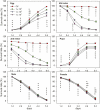Identification and Pathogenicity of a New Entomopathogenic Fungus, Mucor hiemalis (Mucorales: Mucorales), on the Root Maggot, Bradysia odoriphaga (Diptera: Sciaridae)
- PMID: 35303105
- PMCID: PMC8932411
- DOI: 10.1093/jisesa/ieac010
Identification and Pathogenicity of a New Entomopathogenic Fungus, Mucor hiemalis (Mucorales: Mucorales), on the Root Maggot, Bradysia odoriphaga (Diptera: Sciaridae)
Abstract
Bradysia odoriphaga Yang and Zhang (Diptera: Sciaridae), the Chinese chive root maggot, is a destructive pest of Allium vegetables and flowers that causes severe losses in northern China. Novel biological control technologies are needed for controlling this pest. We identified a new entomopathogenic fungus isolated from infected B. odoriphaga larvae and evaluated the susceptibility of the biological stages of B. odoriphaga and the effects of temperature on fungus growth and pathogenicity. Based on morphological characteristics and molecular phylogeny, the fungus was identified as Mucor hiemalis BO-1 (Mucorales: Mucorales). This fungus had the strongest virulence to B. odoriphaga larvae followed by eggs and pupae, while B. odoriphaga adults were not susceptible. A temperature range of 18-28°C was optimum for the growth and sporulation of M. hiemalis BO-1 and virulence to B. odoriphaga larvae. At 3 and 5 d after inoculation with 105 spores/ml at 23°C, the survival rates were 24.8% and 4.8% (2nd instar larvae), respectively, and 49.6% and 12.8% (4th instar larvae), respectively. The potted plant trials confirmed that M. hiemalis BO-1 exerted excellent control efficiency against B. odoriphaga larvae, and the control exceeded 80% within 5 d when the spore concentration applied exceeded 107 spores/ml. In conclusion, these findings supported the hypotheses that this fungus could serve as an effective control agent against B. odoriphaga larvae and is worth being further tested to determine its full potential as a biocontrol agent.
Keywords: Bradysia odoriphaga; biocontrol agent; control efficiency; entomopathogenic fungi; pathogenicity bioassay.
© The Author(s) 2022. Published by Oxford University Press on behalf of Entomological Society of America.
Figures








Similar articles
-
Effects of the Entomopathogenic Fungus Mucor hiemalis BO-1 on the Physical Functions and Transcriptional Signatures of Bradysia odoriphaga Larvae.Insects. 2023 Feb 8;14(2):162. doi: 10.3390/insects14020162. Insects. 2023. PMID: 36835731 Free PMC article.
-
Effects of Feeding on Different Host Plants and Diets on Bradysia Odoriphaga Population Parameters and Tolerance to Heat and Insecticides.J Econ Entomol. 2017 Dec 5;110(6):2371-2380. doi: 10.1093/jee/tox242. J Econ Entomol. 2017. PMID: 29045637
-
A Comparison of Novel Entomopathogenic Nematode Application Methods for Control of the Chive Gnat, Bradysia odoriphaga (Diptera: Sciaridae).J Econ Entomol. 2016 Oct;109(5):2006-13. doi: 10.1093/jee/tow162. Epub 2016 Aug 1. J Econ Entomol. 2016. PMID: 27480971
-
Lethal and sublethal effects of the chitin synthesis inhibitor chlorfluazuron on Bradysia odoriphaga Yang and Zhang (Diptera: Sciaridae).Pestic Biochem Physiol. 2017 Mar;136:80-88. doi: 10.1016/j.pestbp.2016.07.007. Epub 2016 Jul 26. Pestic Biochem Physiol. 2017. PMID: 28187835
-
The Effects of Temperature and Humidity on a Field Population of Bradysia odoriphaga (Diptera: Sciaridae).J Econ Entomol. 2020 Aug 13;113(4):1927-1932. doi: 10.1093/jee/toaa116. J Econ Entomol. 2020. PMID: 32484541
Cited by
-
Accumulation of Fungal Pathogens Infecting the Invasive Spotted Lanternfly, Lycorma delicatula.Insects. 2023 Nov 27;14(12):912. doi: 10.3390/insects14120912. Insects. 2023. PMID: 38132586 Free PMC article.
-
New Mucorales from opposite ends of the world.Stud Mycol. 2024 Dec;109:273-321. doi: 10.3114/sim.2024.109.04. Epub 2024 Sep 18. Stud Mycol. 2024. PMID: 39717656 Free PMC article.
-
Ant's Nest as a microenvironment: Distinct Mucoromycota (Fungi) community of the red wood ants' (Formica polyctena) mounds.Ecol Evol. 2024 Oct 9;14(10):e70333. doi: 10.1002/ece3.70333. eCollection 2024 Oct. Ecol Evol. 2024. PMID: 39385841 Free PMC article.
-
Isolation, Identification, Biological Characterization, and Pathogenicity of Entomopathogenic Fungus from the Larvae of the Evergestis extimalis (Scopoli) (Lepidoptera: Pyralidae).Biology (Basel). 2025 Apr 25;14(5):467. doi: 10.3390/biology14050467. Biology (Basel). 2025. PMID: 40427656 Free PMC article.
-
Effects of the Entomopathogenic Fungus Mucor hiemalis BO-1 on the Physical Functions and Transcriptional Signatures of Bradysia odoriphaga Larvae.Insects. 2023 Feb 8;14(2):162. doi: 10.3390/insects14020162. Insects. 2023. PMID: 36835731 Free PMC article.
References
-
- Angel-Sahagún, C., Lezama-Gutiérrez R., Molina-Ochoa J., Galindo-Velasco E., López-Edwards M., Rebolledo-Domínguez O., Cruz-Vázquez C., Reyes-Velázquez W., Skoda S., and Foster J. E.. 2005. Susceptibility of biological stages of the horn fly, Haematobia irritans, to entomopathogenic fungi (Hyphomycetes). J Insect Sci, 5: 1–8. - PMC - PubMed
-
- Bai, G. Y., Xu H., Fu Y. Q., Wang X. Y., Shen G. S., Ma H. K., Feng X., Pan J., Gu X. S., Guo Y. Z., . et al. 2016a. A comparison of novel entomopathogenic nematode application methods for control of the chive gnat, Bradysia odoriphaga (Diptera: Sciaridae). J. Econ. Entomol. 109: 2006–2013. - PubMed
-
- Bai, Y., Cui Y., Cao N., Liu Y., Ghulam A., and Wang B., . 2016b. Effects of Luz humidity and temperature on the pathogenecity of Beauveria bassiana against Stephanitis nashi and Locusta migratoria manilensis. Chinese J Biol Control. 32: 735–742.
MeSH terms
Substances
Supplementary concepts
Grants and funding
LinkOut - more resources
Full Text Sources

